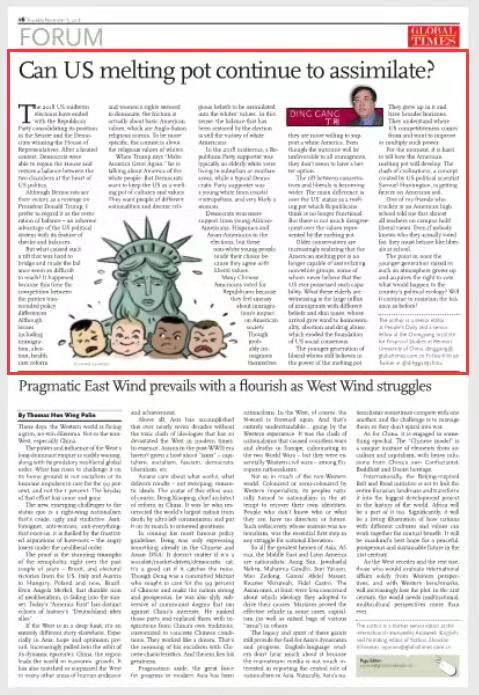Major Power Relations
Your Present Location: PROGRAMS> Major Power RelationsDing Gang: Can US melting pot continue to assimilate?
By Ding Gang Source: Global Times Published: 2018-11-14
The 2018 US midterm elections have ended with the Republican Party consolidating its position in the Senate and the Democrats winning the House of Representatives. After a heated contest, Democrats were able to regain the House and restore a balance between the two chambers at the heart of US politics.

Although Democrats see their victory as a revenge on President Donald Trump, I prefer to regard it as the restoration of balance - an inherent advantage of the US political system with its feature of checks and balances.
But what caused such a rift that was hard to bridge and made the balance seem so difficult to reach? It happened because this time the competition between the parties transcended policy differences. Although issues including immigration, abortion, health care reform and women's rights seemed to dominate, the friction is actually about basic American values, which are Anglo-Saxon religious norms. To be more specific, the contest is about the religious values of whites.
When Trump says "Make America Great Again," he is talking about America of the white people. But Democrats want to keep the US as a melting pot of cultures and values. They want people of different nationalities and diverse religious beliefs to be assimilated into the whites' values. In this sense, the balance that has been restored by the election is still the victory of white Americans.
In the 2018 midterms, a Republican Party supporter was typically an elderly white voter living in suburban or exurban areas, while a typical Democratic Party supporter was a young white from coastal metropolises, and very likely a woman.
Democrats won more support from young African-Americans, Hispanics and Asian-Americans in the elections, but these non-white young people made their choice because they agree with liberal values.
Many Chinese Americans voted for Republicans because they feel uneasy about immigration's impact on American society. Though probably immigrants themselves, they are more willing to support a white America. Even though the outcome will be unfavorable to all immigrants, they don't seem to have a better option.
The rift between conservatives and liberals is becoming wider. The main difference is over the US' status as a melting pot which Republicans think is no longer functional. But there is not much disagreement over the values represented by the melting pot.
Older conservatives are increasingly realizing that the American melting pot is no longer capable of assimilating non-white groups, some of whom never believe that the US ever possessed such capability. What these elderly are witnessing is the large influx of immigrants with different beliefs and skin tones, whose arrival gave wind to homosexuality, abortion and drug abuse, which eroded the foundation of US social consensus.
The younger generation of liberal whites still believes in the power of the melting pot. They grew up in it and have broader horizons. They understand where US competitiveness comes from and want to improve or multiply such power.
For the moment, it is hard to tell how the American melting pot will develop. The clash of civilizations, a concept created by US political scientist Samuel Huntington, is getting fiercer on American soil.
One of my friends who teaches at an American high school told me that almost all teachers on campus hold liberal views. Even if nobody knows who they actually voted for, they must behave like liberals at school.
The point is, once the younger generation raised in such an atmosphere grows up and acquires the right to vote, what would happen to the country's political ecology? Will it continue to maintain the balance as before?
The author is a senior fellow at the Chongyang Institute for Financial Studies at Renmin University of China.























































































 京公网安备 11010802037854号
京公网安备 11010802037854号





